2017 Toyota 86
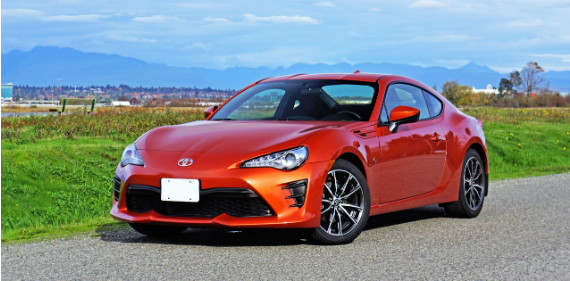
An awesome sports car in search of a worthy automatic option
Scion is dead. Long live Toyota.
The Japanese brand’s youth-oriented sub-brand was an interesting project. It did fairly well in the beginning, particularly in California where it was initiated and headquartered in 2003. Compared to Ford Motor’s Merkur brand (1985–1989) and GM’s Geo (1989–1997)—the General did better with Saturn (1985–2010)—a fourteen-year run is pretty good as far as marketing projects go, the cars it sold only rebranded versions of global Toyota models after all.
It therefore made perfect sense to give the outgoing FR-S a version of its global GT86/FT-86 moniker, the “86” portion of the name paying homage to the now classic rear-drive Corolla GTS/AE86 that’s still tearing up racetracks around the world. This said I’d rather have seen Toyota combine old and new by coining FR-86, being that they don’t have the rights to use the GT86 name here (exclusive to Europe and New Zealand), and FT-86 (only available in Jamaica and Nicaragua). FR-86 makes a bit more sense, but I wasn’t on that marketing panel so I can only wonder what went down within Toyota’s inner circle. As it is, 86 is the name given to the car in Asia, Australia and South America, and we being part of the Americas get the simpler nameplate.
Enough about renaming misnomers, most FR-S/86 fans won’t care all that much about what it’s called, and those purists that give a damn have long been replacing Scion logos with Toyota crests along with chromed FR-S lettering for stylized GT86 badges. They’re already doing the same here in North America, so Toyota continues to inadvertently help online aftermarket vendors trying to make a little extra coin servicing this ultra-niche market.
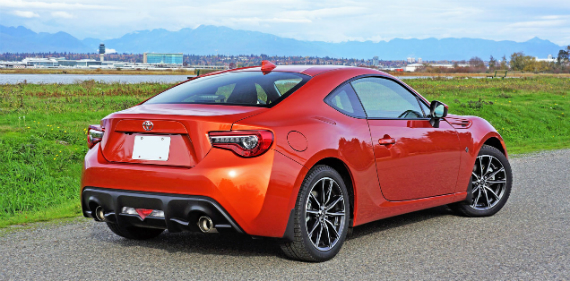
What matters more is the 2017 model’s mid-cycle refresh, a subtle but effective update of a car that had become slightly stale despite still being one of the prettier sports coupes on the market. The big differences to styling come up front, its headlights now incorporating de rigueur full LED elements with LED turn signals, and its lower fascia integrating a more organically stylized center intake with a black mesh insert, plus new triangular-shaped black straked corner “vents” to each side, which are really bezels for fog lamps available from the accessories catalog or 860 Special Edition upgrade (no it’s not 10 times better, but rather it’s allocation is capped at 860 examples).
Ironically, Toyota has removed the circular 86 badge from each of the FR-S’ rather complex front fender engine vents and replaced them with a sleeker more minimal design, while at the back it’s all about new LED taillights. Lastly, new standard 17-inch alloys round out the package.
Toyota has upgraded the new 86’ interior over the outgoing FR-S with more soft synthetic surfaces across the dash top and instrument panel, plus fancy ultra-psuede door uppers, as well as attractive new fabric upholstery featuring black side bolsters with white contrast stitching and gray inserts. There are plenty of satin-silver accents throughout the cabin too, while the old Pioneer-sourced 6.1-inch infotainment touchscreen gets new Toyota-branded graphics and integrates a backup camera, USB integration, Bluetooth phone and streaming audio, plus more.
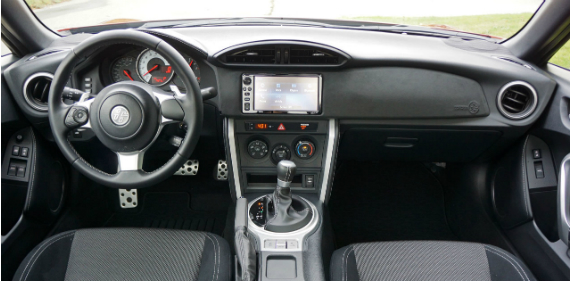
Call it a 2+2, but the rearmost seats are designed more for two 0.5-sized adults or kids, which is par for the course in the compact coupe class. Rather than look at the glass half full, it’s best to appreciate the additional passenger and cargo possibilities offered by the 86’ rear quarters over convertible competitors like Mazda’s MX-5 or Fiat’s 124 Spider, which are solely two-place prospects. I once had a friend show me how he was able to store four racing wheels on slicks with the rear seats of his FR-S folded, which simultaneously told me as much as I needed to know about the car’s practical aspects and performance prowess. The 86, incidentally, gets the same 6.9 cubic-foot trunk as the FR-S, plus its non-split folding rear seatback.
At the heart of that performance-focused ideal, which is really the 86’ raison d’être, the updated model gets a mildly revised version of the FR-S’ Subaru-sourced 2.0-liter horizontally opposed “boxer” four-cylinder. A tweak here and mod there has allowed for a minor bump from 200 horsepower to 205 and 151 lb-ft of torque to 156, but only six-speed manual (6M) equipped cars get the upgrade, along with a revised rear differential for quicker launches from standstill up to speed. Those fitted with the paddle-actuated six-speed automatic (6A) featuring rev-matched downshifting via Toyota’s “Dynamic Rev Management” system, as was the case with my Hot Lava painted tester, carry forward with the unmodified engine, albeit both now include standard hill start assist.
I already drove and reviewed a new 2017 Subaru BRZ with the manual and therefore experienced the same performance boost, which is more about where in the rev-range that power and torque gets applied than noticeable increases in output. The extra mid-range punch would’ve helped the autobox, but alas no such luck. As noted the 86 6A included paddle shifters behind the ideally formed leather-wrapped steering wheel, something I usually appreciate in everything from sport-luxury sedans and SUVs to sports cars like this, if the automatic or dual-clutch gearbox they’re hooked up to shifts crisply enough to feel performance-oriented and holds its gears (i.e. not a CVT), but the optional automatic in the 86 is not as sporting as I prefer. The engine is willing, but the six-speed auto is a bit sluggish and therefore hardly exciting, even when set to Sport mode. On top of this it doesn’t offer the same level of control as a manual, negating the lively nature of this car. I understand some love the 86 just for its styling and appreciate its sublime handling yet would rather have the convenience of an automatic over the manual, but for me the manual is the only way to go in this car.

On the positive, the suspension gets retuned for both manual and automatic models, with revised damping that makes it smoother without hampering its edgy goodness. In fact, I’d say it’s better than the previous iteration, at least for real-world driving over fast-paced two-lane backroads where ruts and bumps often combine to unsettle more stiffly sprung setups. The 86 tracks nicely over such uneven pavement, proving near unshakable even through the roughest sections, while it continues to provide some of the most intricately detailed steering feedback in the industry. Yes, I still love this car, just not as much with the automatic gearbox.
Toyota continues to follow Scion’s lead by keeping the new model’s trims to a minimum, simply offering the 86 6M and 86 6A, plus the 860 Special Edition mentioned earlier. Standard features not yet mentioned include a limited slip differential, 215/45R17 tires, auto on/off LED headlamps, power-adjustable side mirrors, remote keyless entry, a tilt and telescopic leather-wrapped multifunction three-spoke sport steering wheel, a leather-clad shift knob and handbrake handle, aluminum sport pedals, a trip computer/multi-info display, cruise control, variable intermittent wipers, air conditioning, eight-speaker AM/FM audio with aux and USB inputs plus an Automatic Sound Levelizer (ASL), Bluetooth phone and streaming audio, a six-way manually adjustable driver’s seat, power windows with auto up/down all-round, dual vanity mirrors, all the usual active and passive safety equipment, and more.
On top of this the $29,155 860 Special Edition, which moves up to $29,875 with the automatic, adds fog lamps, a rear spoiler featuring black-painted accents, black side mirror housings with heatable mirrors, proximity-sensing keyless access, pushbutton ignition, a 4.2-inch color TFT multi-information display with vehicle performance data, dual-zone auto climate control, leather upholstery, heatable front seats, and an alarm. That’s certainly the one I’d want to live with every day, but that’s not the one I was given to test.
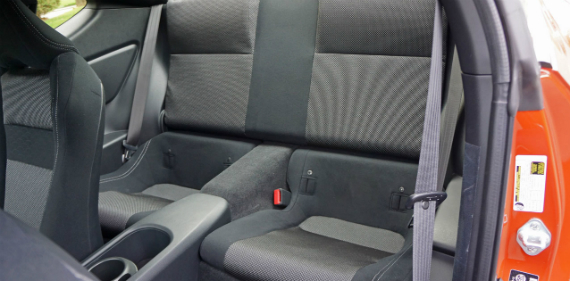
Also important, like the FR-S and Scion in general, the new Toyota gets plenty of accessories to spice up the look and add to the experience overall, including the usual block heater, exterior protection film wraps, hood and side window deflectors, rear spoiler, and cargo liner, plus the less expected Bongiovi Acoustics DPS sound system upgrade; the Extension Box premium display audio system with navigation, Push-to-Talk voice recognition, various apps such as Aha, Harman on iTunes, and Google Play, etcetera; gorgeous 18-inch TRD lightweight alloys; TRD sport exhaust; TRD 1 1/8th-inch lowering spring kit; TRD performance air intake; TRD performance front and rear brake pads; and stiffer gloss red powder coated TRD sway bars.
As is understandable due to new standard features, the 86 adds $950 to last year’s base FR-S price tag, the new tally still in the mid-$20k range at $26,255 for the manual and $26,975 for the auto, plus freight and fees. One thing to consider is the aforementioned BRZ, however, which was previously pricier yet can now be had for just $25,495. The two cars were developed side-by-side and use many of the same components, especially at the core, so keep both the Subie in mind when shopping, and for that matter throw in a visit to your local Nissan dealer for a look at the repositioned 370Z that starts at just $29,990 with its 332 horsepower V6 included.
Of course, the Z’s big 3.7-liter V6 won’t provide anywhere near the 86’ superb fuel economy, its EPA estimate being 21 mpg in the city, 28 on the highway and 24 combined for the manual, or 24 city, 32 highway and 27 combined for the auto, both aided by D4-S direct and port fuel injection.
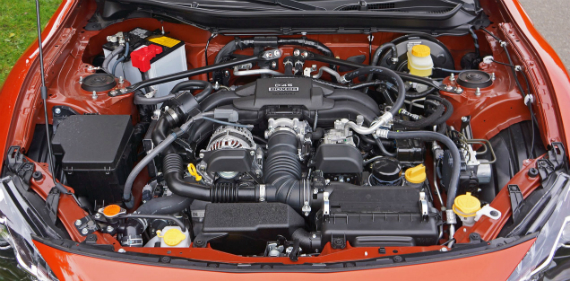
In case you’re wondering, there are plenty of 2017 86 models still available across the country. So many, in fact, that Toyota hasn’t even introduced the 2018 model yet, and at the time of writing we’re well into December. Sadly, it’s not as big a seller as it used to be, but neither is anything else in the segment. In fact, it’s been a fairly bad year for mainstream branded sports cars, with only Fiat’s 124 Spider achieving any headway, and being the newest kid on the block its sales could only go up.
In order to stay relevant Toyota will want to improve the automatic transmission’s performance, and for that matter add more than 5 horsepower to an engine that has long been criticized for a performance shortfall. I’m not in this camp, happy with the 86’ acceleration when hooked up to the manual and more than satisfied with its handling prowess, especially after this year’s upgrades, but apparently I’m in the minority.
Story credits: Trevor Hofmann, American Auto Press Photo credits: Karen Tuggay, American Auto Press Copyright: American Auto Press
